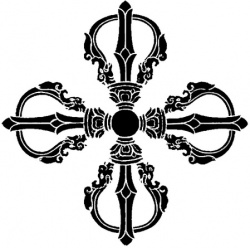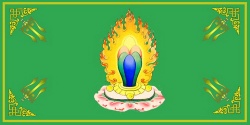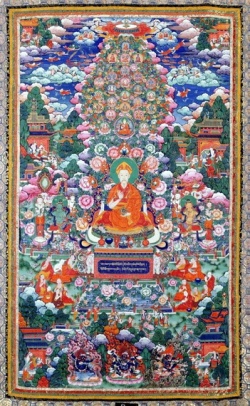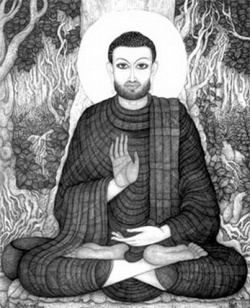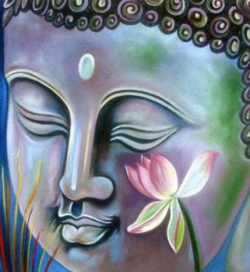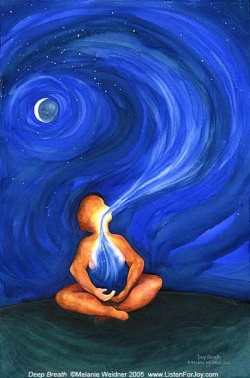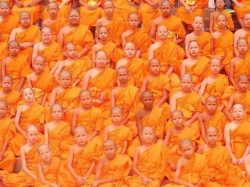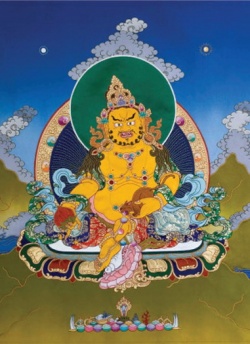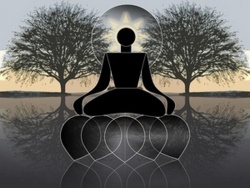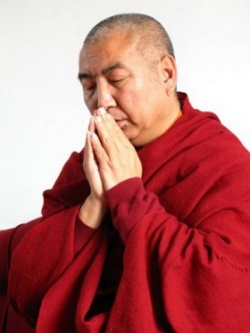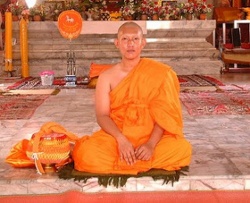Explanation Of The Rinchen Terzod
Explanation Of The Rinchen Terzod
Tib., rin-chen gTer-mDzod chen-mo: Precious Treasure Trove of the Great Mother
Rinchen Terzö is the most often used, short form of Rinchen Terzö Chenmo; sometimes shortened further to Terzö (gter mdzod; treasure trove).
All these names refer to a 63 volume collection of revealed texts, i.e. terma, compiled and edited in the 19th century by the two Rimed masters Jamgön Kongtrül Lodrö Thaye (1813-1899) and Jamyang Khyentse Wangpo (1820-1892).
The collection consists of the most important terma hidden in the 8th and 9th centuries by Padmasambhava, Yeshe Tsogyal, Vimalamitra, and their foremost students; to be found and/or revealed in the course of history by the major terton.
The work, published in New Delhi by Dilgo Khyentse Rinpoche (1910-1991), contains many of the most important texts of the so-called Early Translation School, i.e. the Nyingma tradition; among which the 17 Tantras belonging to the Mannagde (Concealed Instruction) Series.
The Rinchen Terzod (the Precious Treasury of Terma) is one of the most sacred and important sets of transmissions of the Nyingma School of Tibetan Buddhism. In the Nyingma, or Early Translation School, great masters such as Guru Rinpoche, Vimalamitra, and Vairotsana, among others, gave teachings which were concealed during their own time and later discovered by eminent masters who came between the 11th and 19th centuries.
In the late 19th century, in an effort to save these precious works from permanent obscurity, they were collected into the Rinchen Terzod, comprised of 64 volumes of Tibetan text. This collection was described by the 15th Gyalwang Karmapa as "the quintessence of the ocean-like teachings of the (Awakened Ones), the profound [collection of the Awareness Holders] of the Early Translation School."
The empowerment rituals of the Rinchen Terzod are rarely performed, as they take 3-6 months to complete; this cycle of empowerments has only been given once before in the Western world, by Kyabje Penor Rinpoche in 1988.
The Subject of the Rinchen Terzod
It is generally considered that Padmasambhava, known familiarly to Tibetan Buddhists as Guru Rinpoche, was the primary Indian master responsible for establishing Buddhism in Tibet in the 8th century. Other major figures who contributed, especially to the establishment of the innermost teachings of the Buddha known as the Vajrayana, were another Indian master named Vimalamitra and the Tibetan translator Vairochana. In addition, Guru Rinpoche had 25 greatly accomplished disciples, among whom was Tibet's king, Trisong Deutsen, and a woman considered to be the foremost of these 25, Yeshe Tsogyal.
Tibetan Buddhist religious history tells us that Guru Rinpoche, with enlightened foresight, understood that there were many teachings that would benefit future generations more than the people of his own time. Guru Rinpoche and Yeshe Tsogyal together concealed these teachings, along with many sacred objects, in various places throughout Tibet. Guru Rinpoche then taught his 25 disciples particular aspirational prayers to be recited so that in future incarnations they would discover these teachings at the appropriately beneficial time.
From Sangye Lama in the 11th century up to the present day, the discoverers of these teachings have been known as tertöns —treasure revealers. The teachings and sacred objects that they discovered are known as terma—treasures. It is these terma, generally unique to the Nyingma school, that form the subject of the Rinchen Terzod.
How the Rinchen Terzod was Compiled
In the 19th century, three great masters who would be directly responsible for the Rinchen Terzod were born in eastern Tibet: Jamyang Khyentse Wangpo (1820-1892), Chokgyur Lingpa (1829-1870), and Jamgön Kongtrul Lodrö Thaye. Jamyang Khyentse Wangpo and Chokgyur Lingpa became treasure revealers of wide renown. Jamgon Kongtrul was a heart disciple of both of these lamas, and received all of their treasure teachings as well as many more.
Jamgon Kongtrul became alarmed by the possibility of many of the profound terma, especially the older ones, being lost to this world. At first he gathered many of them into a 10-volume collection known as the Small Precious Treasury. Asking his teacher Jamyang Khyentse Wangpo about putting together a larger collection of as many of the extant terma as possible, it was agreed this was a crucial task, and Jamgon Kongtrul the one to perform it. Jamyang Khyentse Wangpo even rediscovered some of the lost teachings and entrusted them to Jamgon Kongtrul, along with the injunction that he should gather as many of the others as he could. The importance of this endeavor was further confirmed in a letter to Jamgon Kongtrul from Chokgyur Lingpa, saying he had had a direct vision of Guru Rinpoche who told him to give his own terma appropriately, and that Jamgon Kongtrul was the right recipient.
With both of his teachers' blessings, Jamgon Kongtrul devoted much of the rest of his life to creating the Rinchen Terzod. Patiently undergoing great hardship, Jamgon Kongtrul traveled all over Tibet. He himself received the necessary empowerments and reading transmissions for the various terma from contemporary lineage holders, as well as collecting copies of the texts. When completed, the Rinchen Terzod totaled 64 volumes of terma from a wide range of treasure revealers.
The Purpose of Compiling the Rinchen Terzod
Through the 1000-year history of the terma teachings in Tibet, there was a tendency for practitioners to focus on the terma which had been more recently discovered. Thus, the practice of some of the profound, older terma had gone into decline. In some cases, their lineages had been lost altogether. Additionally, some terma teachings had been discovered and were practiced in very remote, lightly populated regions of Tibet, and for this reason were under threat of extinction.
As a result of Jamgon Kongtrul's great efforts to assemble all of these terma into the Rinchen Terzod, many of Tibetan Buddhism's highest teaching cycles were safeguarded from disappearing altogether, and preserved for the benefit of future generations of Tibetan Buddhist practitioners.
Additional Information about Terma (Treasure Teachings)
According to traditional explanation, a brief description of terma (the "treasure teachings" of Tibetan Buddhism) consists of five categories:
1. The identification of terma;
2. The lineage of terma teachings;
3. The categorization of terma;
4. The clarification of misunderstandings about terma, and;
5. The purpose of terma.
The Identification of Terma
The literal meaning of ter is "inexhaustible." Certain accomplished masters, with great wisdom and compassion for future generations, were said to have the power to seal into invisibility profound teachings, ritual objects, and valuable substances until the propitious time for their rediscovery. The authentic terma are thought to provide special blessings due to their unbroken lineage, pure origins, unchanged words, and perfect meanings.
Particularly in Tibet, terma are mostly associated with Padmasambhava (Guru Rinpoche), the Indian master credited with establishing Buddhism in Tibet in the 8th century. With his spiritual consort and foremost disciple Yeshe Tsogyal, he traveled throughout Tibet to conceal terma. In general, it is said that he concealed 108 major terma, 1000 minor terma, and innumerable others scattered across the Tibetan plateau.
The discoverers of these terma are always incarnations of one of Guru Rinpoche's 25 most accomplished disciples, who made specific aspirational prayers just for this purpose. Three of the earliest tertöns were Sangye Lama (1000-1080), Nyangral Nyima Oser (1124-1192) and Guru Chowang (1212-1270). The phenomenon of terma revelation, transmission, and practice has continued until the present day. Such cycles of revelation, appearing as very fresh, pure methods to swiftly accomplish supreme enlightenment, are known as the Close Lineage of Treasures.
The Lineage of Terma
In Buddhist cosmology, our present era is known as a degenerate time. In such a time, enlightenment teachings can be subject to the interpolation of contradictory instructions, impure practice, and other interference throughout the generations such that they lose their potency or effectiveness, or the lineage becomes lost altogether.
The terma teachings are Guru Rinpoche's uniquely skillful method for counteracting the degenerate times. Their periodic arising ensures that efficient techniques for experiencing the true nature of mind beyond suffering, with the full strength of their blessings intact, are always available to sentient beings seeking to liberate themselves and others.
Depending on how they are counted, there are six, seven, or nine methods for transmitting terma lineages. The first three—Mind-to-Mind, Symbolic Indication, and Aural Transmission—make up the first three, and when The Secret Entrustment of the Dakinis, The Bestowal of Empowerment Along with Aspiration, and The Yellow Parchment Word Transmission are added, this makes six. If this last is eliminated, and the Transmission of Spiritual Connection and The Blessed Transmission of Experience are added, this becomes seven. Adding an addition two—The Unadorned Aural Lineage and The Practice of the Four-fold Activities Transmission—are folded in, this makes nine methods of terma transmission altogether.
The Categorization of Terma
It is said that in reality there are innumerable kinds of terma with techniques for liberating innumerable sentient beings with their various mental dispositions. For the sake of expediency, however, the following general categories of terma teachings are named:
1. Terma categorized according to place— Terma caches revealed from the earth, rocks, mountains, cliffs, lakes, and so on are known as earth terma; the texts mystically concealed in space and appearing at a particular time to the destined master are called space terma; those which spontaneously arise in the clear light mind of a master's perfect meditative stability are called mind terma; and those which appear in the visionary experience of an undeluded and purified mind are called pure vision terma.
2. Terma categorized according to its nature— The teachings that reveal the vast and profound qualities of the Buddha's doctrine and its commentaries are called dharma terma; those that are in the form of rare and precious objects are called valuable terma; and those which consist of nectar, medicine, and so forth are called terma of sacred substances.
3. Terma categorized according to the means of revelation— The treasures that are revealed in absolute secrecy are called secret terma; those which are revealed in front of others are called public terma.
4. Terma categorized according to its main theme— Treasures which present a complete path for attaining perfect Buddhahood are called major terma; those which present methods for more minor accomplishments are called minor terma.
5. Terma categorized according to its direction— There are some treasures which have a symbolic correlation according to direction: the ripened eastern treasure of fruit, the integrated southern treasure of the stem, the radiant western treasure of the flower, the dispersed northern treasure of the branches, and the deeply-rooted treasure of the center. Others such as those which contain instructions on the practice of the Three Roots are called root terma; those presenting such practices as Guru Yoga or Avalokiteshvara sadhanas, or pith instructions on the highest methods of Dzogpa Chenpo, are called (fruit terma; and there are myriad other inner sub-divisions of terma.
The Clarification of Misconceptions About Terma There are some who criticize the terma teachings as just a mental fabrication of the Tibetans, and claim as their reason that no Indian antecedents can be found. Such is not the case, however, as there are many examples from India.
Acharya Jampel Shenyen concealed all the oral teachings of tantric essence under the huge rock sealed on top by a crossed vajra to the northeast of Vajrasana (Bodh Gaya), India. Likewise, The Sutra on the Five Aggregates was concealed within the Pedra Retra Stupa. Once, while the Brahmin Demed Legnang was accompanying the Buddha along the way, there arose different sounds and lights from a protrusion of soil on the old stupa. The Buddha with his eyes full of tears prostrated and circumambulated it. When Vajrapani asked him about it, he said that there is the treasure of the essence within.
The Chinese version of the Lankavatara Sutra says that Madoepa, the King of Nagas, offered a conch shell to the Buddha, which was handed over to Maudgalyana with the command that he conceal it as a treasure at Mount Gogpa. There are numerous other examples.
Other criticism states that treasure teachings are not mentioned in either the Buddha's teaching or in the commentarial canon. This is also false. The All Surpassing Merit Gathering of the Concentrative Sutra reads, "Jampel, the four elements arise from the sky treasure. Likewise, all the virtuous teachings arise from the heart of the Buddha. Hence, make use of this treasure's purpose."
Further, The Concise Tantra of Supreme Bliss says:
"Tantras and the king of tantras—
You, Vajrapani,
Will extract from the treasury and bestow."
Some persist in denying the validity of the treasure teachings, saying they are only found in the Nyingma tradition and not present in the newer traditions. On the contrary, we can find examples such as the Wrathful Mantra of Fourteen Syllables, which was revealed as a treasure in India by the translator Rinchen Dak, contained in the thirteen well-known golden volumes of the Sakyapas. Also, the great Master Tsongkhapa revealed the treasure of The Two Masks of Chogyal, and The Conch Shell, which was prophesied in the Chinese version of the Lankavatara Sutra. It's possible to find examples of terma in all Tibetan Buddhist traditions, including from the Fifth Dalai Lama.
The Purpose of Terma
Of the many reasons for the concealment and rediscovery of terma, the sublime master of the 18th century, Jigme Lingpa, highlights four: "...to maintain the doctrine's continuity, to avoid corrupted instructions, to keep the blessings intact, and to keep the lineage closer to the origin of the teachings."
Furthermore, the profound treasures upon their mere revelation are said to radiate blessings in the immediate area such that the strength of nonvirtue declines, virtue increases, and there is pacification of seasonal calamities, disease, famine, war, and so forth. The terma also clear the obstacles to longevity, and hindrances to the activities of the doctrine holders. In brief, they benefit everyone by enhancing the teachings, wealth, sacred substances, etc., and give rise to the four-fold liberation. Even at the end of this degenerate era, when the Vinaya doctrine of the sutras disappears, the secret tantric teachings of Vajrayana will still be propagated. Their continuity will cause vast benevolent activities to lead all the untamable beings to perfect liberation.
From the words of Guru Rinpoche:
"The terma will be the final doctrine to maintain the teachings in the degenerate era."
It is said that the liberating activities of the profound terma will not cease until the advent of Buddha Maitreya's teachings.
The Benefits of Receiving Empowerments
An authentic Vajra Master bestows empowerments by conducting a perfect ceremony for faithful and devoted disciples. Those recipients with sharp faculties realize the ultimate wisdom of the empowerment upon the mere bestowal; the mediocre ones begin experiencing wisdom; and those with inferior faculties develop mere understanding. Through tilling, hard, fallow ground can become soft earth, and then, by planting a seed and assembling the conditions of manure, heat, and moisture, slowly the sprout will grow until finally the fruit ripens. In the same way, disciples who previously lacked the ability to develop their qualities, like the hard, barren ground, are purified by empowerment, becoming suitable for the planting and growth of the seeds of the four kayas.
In this case, the conditions are the exertions of effort on the path of generation and completion stage meditation related to that empowerment. Through this effort, with every single moment, grasping to the three doors of body, speech and mind) and to their distinctness (which make four altogether), and obstructions such as karma, afflictions, and cognitive habitual tendencies, the four temporary obstructions, and so forth, are all gradually purified. The nature of the four paths of learning, the thirty-seven aspects of enlightenment, the ten perfections, and the two accumulations (of merit and wisdom)—intensified by the two stages of generation and completion' gradually develop. Finally, the four vajras of body, speech, mind, and wisdom; the four kayas; and other inherent qualities become evident as one is freed from obscurations and actualizes fruition.
As stated in The Condensed Sutra of Anuyoga:
The great magnanimous victor
Who emerged from the three indivisible kayas
adorned with the ocean of wisdom—
[That state] will be obtained in this very life.
Particularly, the importance of the empowerment for accomplishing the path of secret tantra is explained in The Luminous Essence, a commentary to the Guhyagarbha Tantra: "Briefly, the empowerment is the first and only door to the path of Vajrayana; it is a dynamic method that dominates the practice and the fruition. Relying upon this, the view of Vajrayana will arise in our mental continuum. Through practice in accordance with the view, one achieves capability in the vajra-conduct."
The empowerment makes the sadhana practice, offerings, activity, recitation of mantra, and gesture of mudra meaningful, and through it we obtain the samaya vows. Therefore, the empowerment is like the source of all. It is like the king who promotes one to ever greater positions. Each and every Vajrayana teaching is dependent upon empowerment.
In the ultimate reality, there is no bestowing and no receiving because the nature of all phenomena is the perfection of the Dharmakaya. With this realization, the self-awareness empowerment is simultaneously actualized, consummating all empowerments.
The Faults of Not Receiving Empowerments
The Tantra of Unions says:
Not having engaged in the mandala,
The samayas being abandoned,
And without knowing the secret reality,
Although practiced, it would be fruitless.
And the Tantra of the Buddha's Skull says:
Like a childless home
Becomes desolate by a mere death,
Likewise, when separated from the empowerment,
One will be devoid of all wisdom. Like a guitar,
If stringless, cannot be sounded,
Likewise, without empowerment,
Mantra and meditation will not be of any use.
